The Samsung Galaxy Tab S2 Review
by Brandon Chester on October 15, 2015 8:00 AM ESTDisplay Analysis
Before getting into our typical display analysis, I wanted to address a question that I'm sure some people have. A quick examination of a Tab S2 8.0's subpixel arrangement confirms that the smaller model uses a PenTile subpixel arrangement, and there's significant artifacting on the edges of icons and text, with the issue being very pronounced with thin weighted fonts. This is a big disappointment for users who prefer small tablets, and I would almost hesitate to recommend the smaller model for that reason alone because of how prevalent the issue is.
While the smaller model of the Tab S2 uses diamond PenTile, the Tab S2 9.7" does use an RGB-like subpixel arrangement, and it's essentially the same as the one used on the original Tab S 10.5. In practice there aren't really any artifacts as a result of the subpixels not being lined up exactly like a conventional LCD display, and it looks every bit as sharp as the iPad Air 2 which is exactly what I had hoped for.
To test the various attributes of the Tab S2 9.7's display I've run it through out standard display workflow. All measurements are done with an X-Rite i1Pro 2 spectrophotometer, and in the case of LCD devices the contrast measurements are done with an i1Display Pro colorimeter. SpectraCal's CalMAN 5 software is used for measuring and collecting data, and for generating graphs that are relatively easy to understand.
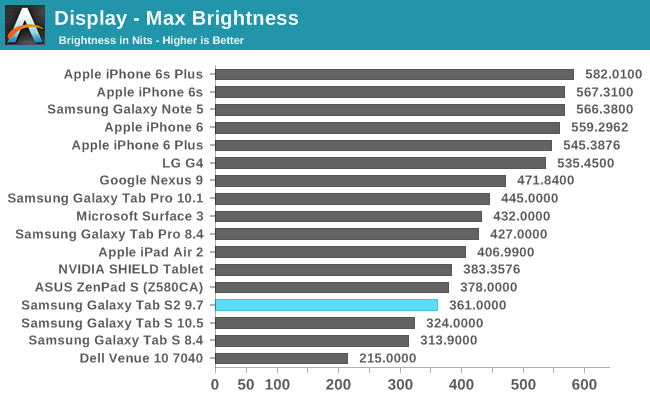
The Average Picture Level (APL) of an image can be thought of as a percentage expressing the luminance relative to a 100% white display. Since AMOLED displays target a given power consumption but can save power by turning off black pixels they can push a higher maximum brightness when the display's APL is low. Above you can see how the maximum brightness of white scales with average picture level. Real world use cases tend to be somewhere around 80% APL, and while there are always exceptions, this trend has continued with Google's new guidelines for designing Material Design applications. What's important about this chart is it shows that in most scenarios the Tab S2 9.7 actually isn't any dimmer than a tablet like the iPad Air 2, and much brighter than the original Tab S.
As for contrast, there's no point in displaying a chart, as Samsung's AMOLED displays can simply shut off pixels and achieve infinite contrast and true blacks. There's really nothing that comes close on any LCD-based tablet, and the true blacks of AMOLED displays simply become even more stunning as you scale up from a phone to a tablet, and again from a tablet to a television.
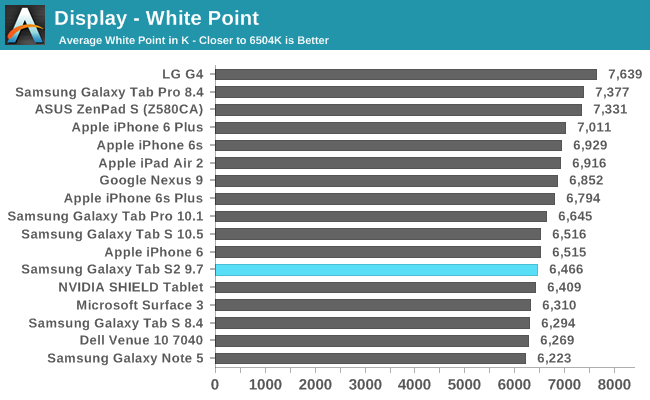
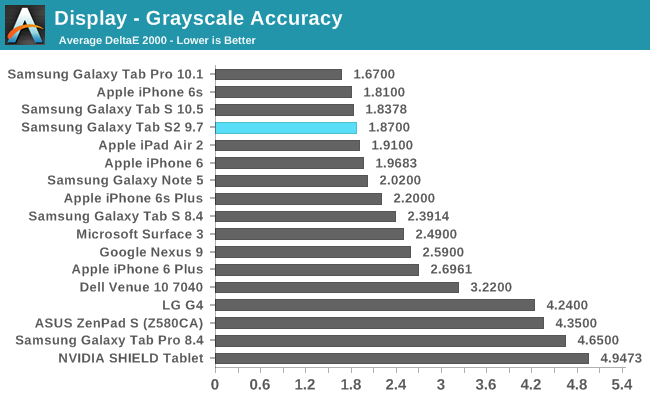
Samsung's AMOLED calibration has improved tremedously in recent years, and the Tab S2 9.7 is no exception. The greyscale has a very high level of accuracy, with very low errors across the board. When you move past 70% white there is a degree of green tinting to whites and greys that appears, and this is noticeable during general use. I did find it to be somewhat bothersome, but I think this is mostly due to the fact that I test and use many different devices regularly. If the Tab S2 9.7 was my only tablet I would be perfectly happy with the level of calibration, and I would get used to the good but not perfect calibration when shades approach 100% white.
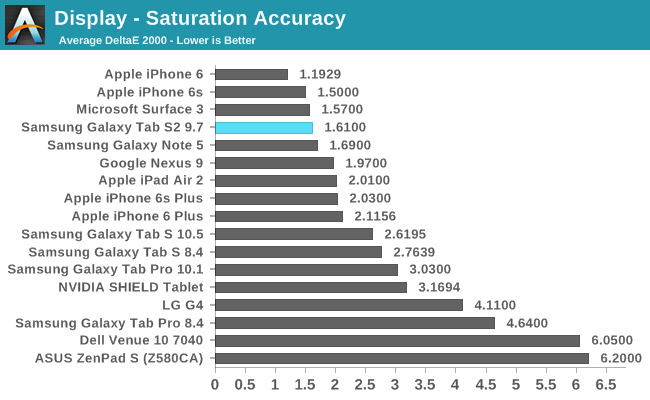
Saturation accuracy on the Tab S2 9.7 is phenomenal. It's better than every other tablet except for the Microsoft Surface 3, and at this point you would really be hard pressed to see errors in the rendering of pure primary and secondary colors. Most of the errors seem to be at the very extreme 100% saturations, and in daily use I never felt like the appearance of colors was off in any way.
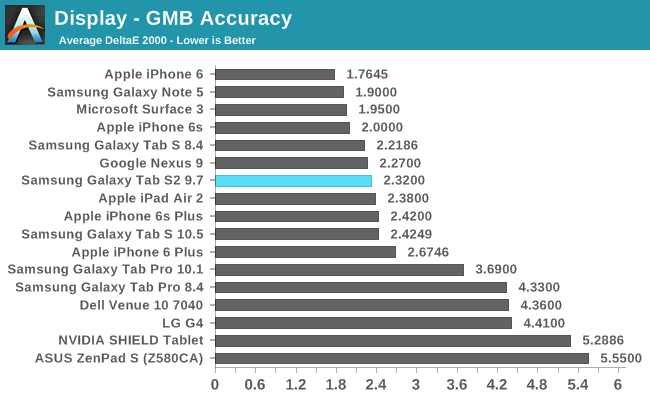
In the Gretag-Macbeth ColorChecker test we again see a very high level of color accuracy on the Tab S2 9.7. The biggest contribution to errors are actually the grey shades that are tested, along with some slight errors in red and blue based color mixtures. To criticize these results would honestly be pedantry, as unless your tablet workflow involves editing videos and photos with absolutely no visible color errors the Tab S2 9.7 provides a more than sufficient level of accuracy.
There's really not much else to say about the Tab S2 9.7's display. Samsung has really done a great job with calibrating the displays on recent AMOLED devices, and the Tab S2 9.7 offers a display that is just as good as any other tablet. One could argue that the true blacks actually put the Tab S2 9.7 ahead of the competition, and I would be inclined to agree. My only complaint is that the iPad Air 2 with its AR coating tends to be a bit more usable outside and in other scenarios where there are heavy reflections. There's really no way to conclude which tablet offers the absolute best display, but I think it would be correct to say that in most cases the Tab S2 9.7's display is as good, if not better than any other tablet on the market.


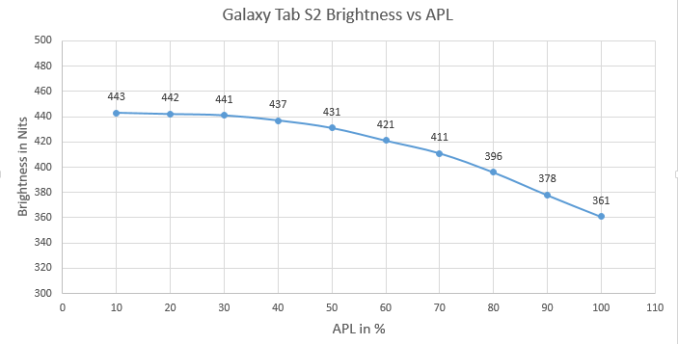
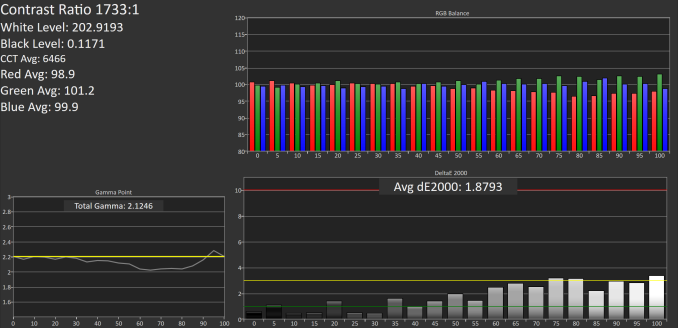

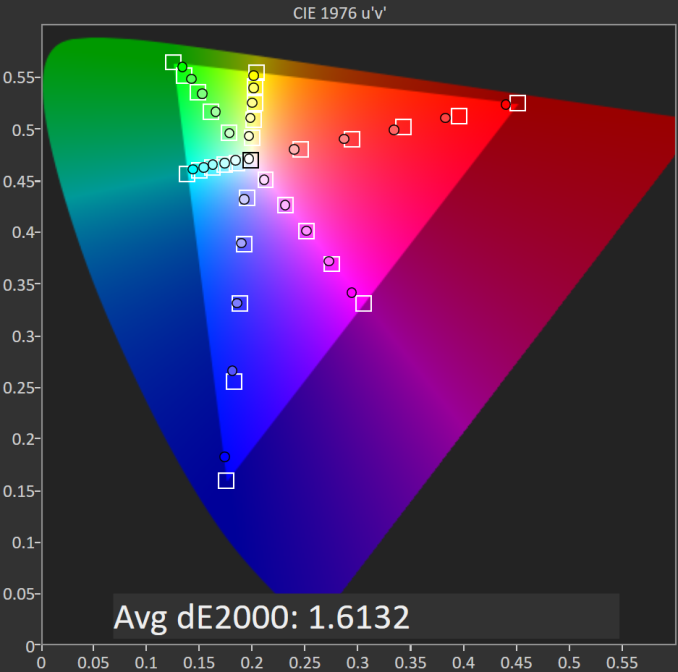










162 Comments
View All Comments
KoolAidMan1 - Saturday, October 17, 2015 - link
Samsung is just a foundry for Apple's designs. Just because they produce Apple's SoCs doesn't mean that they are entitled to using them in their own devices.psychobriggsy - Thursday, October 15, 2015 - link
Thanks for the review. A pretty poor showing from Samsung, for the price they want.All the review has done is show how worthwhile getting an iPad Air is.
cknobman - Thursday, October 15, 2015 - link
Agreed, not sure how this gets a good review.Horribly priced this needs to be <= $300.
FlyBri - Thursday, October 15, 2015 - link
@cknobman Totally agree. I'm really hoping Samung releases a higher end tablet soon with much better performance and battery life. The Tab S2 is fine, but comparing the specs and price to an Air 2, it has to much less than what Samsung wants.ummduh - Thursday, October 15, 2015 - link
I don't understand why Samsung continues to do this. They have the capability to make great hardware, and they do with their phones. But their tablets are just all around terrible. OK, well, they'd be great if they were sub $200. Seems like every tablet they've made has had some sort of huge fatal flaw, and some of them had multiple fatal flaws. I don't think I've ever seen Samsung make a compelling tablet.zodiacfml - Thursday, October 15, 2015 - link
It's all good, the performance and battery life but the price. An expensive picture frame and reader.Der2 - Thursday, October 15, 2015 - link
DAT nichijou episodes tho. I better see OPM on the next phone/tablet review haha. Good review as always Brandon.RGagne1975 - Thursday, October 15, 2015 - link
Looks like my Nexus 9 is still worth keeping. I guess I will have to wait for the review of the next Nexus tablet to see if I will want to upgrade or not.R. Hunt - Thursday, October 15, 2015 - link
I have to disagree with the reviewer about the quality of the screen. Text on the iPad Air 2 looks noticeably sharper than on the Tab S2 9.7, despite having the same ppi. I'm not sure if it's the screen itself or the rendering done by the OS has any influence on it, but I wasn't happy about it at all.The review also claims the original Tab S 10.5 had a pixel density of 320 ppi. Pretty sure that's not right and it was below 290 ppi.
Brandon Chester - Thursday, October 15, 2015 - link
Android's font rendering is a completely different topic, but it's definitely not the display itself. If you use both platforms regularly you sort of become accommodated to the differences, not unlike how one eventually gets used to how Windows and OS X render fonts completely differently.As for the PPI, you're correct. I must have messed up my math pretty badly there.